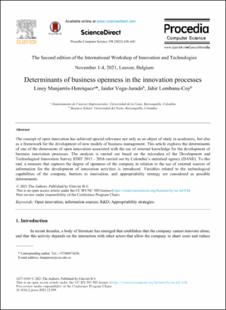Mostrar el registro sencillo del ítem
Determinants of business openness in the innovation processes
| dc.rights.license | Atribución-NoComercial-SinDerivadas 4.0 Internacional (CC BY-NC-ND 4.0) | spa |
| dc.contributor.author | Manjarres-Henriquez, Liney | |
| dc.contributor.author | VEGA-JURADO, JAIDER | |
| dc.contributor.author | Lombana, Jahir | |
| dc.date.accessioned | 2022-10-07T13:03:37Z | |
| dc.date.available | 2022-10-07T13:03:37Z | |
| dc.date.issued | 2022 | |
| dc.identifier.citation | Liney Manjarrés-Henriquez, Jaider Vega-Jurado, Jahir Lombana-Coy,Determinants of business openness in the innovation processes, Procedia Computer Science,Volume 198,2022,Pages 638-643,ISSN 1877- 0509, https://doi.org/10.1016/j.procs.2021.12.299. | spa |
| dc.identifier.issn | 1877-0509 | spa |
| dc.identifier.uri | https://hdl.handle.net/11323/9563 | |
| dc.description.abstract | The concept of open innovation has achieved special relevance not only as an object of study in academics, but also as a framework for the development of new models of business management. This article explores the determinants of one of the dimensions of open innovation associated with the use of external knowledge for the development of business innovation processes. The analysis is carried out based on the microdata of the Development and Technological Innovation Survey EDIT 2015 - 2016 carried out by Colombia’s statistical agency (DANE). To this end, a measure that captures the degree of openness of the company in relation to the use of external sources of information for the development of innovation activities is introduced. Variables related to the technological capabilities of the company, barriers to innovation, and appropriability strategy are considered as possible determinants. | eng |
| dc.format.extent | 6 páginas | spa |
| dc.format.mimetype | application/pdf | spa |
| dc.language.iso | eng | spa |
| dc.publisher | Elsevier BV | spa |
| dc.rights | © 2021 The Author(s). Published by Elsevier B.V. | eng |
| dc.rights.uri | https://creativecommons.org/licenses/by-nc-nd/4.0/ | spa |
| dc.source | https://www.sciencedirect.com/science/article/pii/S1877050921025382?via%3Dihub | spa |
| dc.title | Determinants of business openness in the innovation processes | eng |
| dc.type | Artículo de revista | spa |
| dc.identifier.url | https://doi.org/10.1016/j.procs.2021.12.299. | |
| dc.rights.accessrights | info:eu-repo/semantics/openAccess | spa |
| dc.identifier.doi | 10.1016/j.procs.2021.12.299 | |
| dc.identifier.instname | Corporacion Universidad de la Costa | spa |
| dc.identifier.reponame | REDICUC - Repositorio CUC | spa |
| dc.identifier.repourl | https://repositorio.cuc.edu.co/ | spa |
| dc.publisher.place | Netherlands | spa |
| dc.relation.ispartofjournal | Procedia Computer Science | spa |
| dc.relation.references | Barge-Gil A. Open, Semi-Open y Closed Innovators: Towards an Explanation of Degree of Openness Industry and Innovation, 17 (6) (2011), pp. 577-607 | spa |
| dc.relation.references | Cassiman B., Valentini G. Strategic organization of R&D: The choice of basicness and openess Strategic Organization, 7 (1) (2009), pp. 43-73 | spa |
| dc.relation.references | Chesbrough H, Bogers M. Explicating Open Innovation: Clarifying and Emerging Paradigm for Understanding Innovation, Oxford University Press (2014), pp. 3-28 | spa |
| dc.relation.references | Chesbrough H. Open Business Models: How to Thrive in the New Innovation Landscape, Harvard Business School Press (2006) | spa |
| dc.relation.references | Chesbrough H. The era of open innovation Sloan Management Review, 44 (3) (2003), pp. 35-41 | spa |
| dc.relation.references | Cohen W., Levinthal D. Absorptive capacity: a new perspective on learning and innovation Administrative Science Quarterly, 35 (1) (1990), pp. 128-152 | spa |
| dc.relation.references | Dahlander L, Gann D. How open is innovation? Research Policy, 39 (2010), pp. 699-709 | spa |
| dc.relation.references | Ghisetti C., Marzucchi A., Montresor S. The open eco-innovation mode. An empirical investigation of eleven European countries Research Policy, 44 (2015), pp. 1080-1093 | spa |
| dc.relation.references | Heckman J. Sample Selection Bias as a Specification Error Econometrica, 47 (1) (1979), pp. 153-161 | spa |
| dc.relation.references | Klein K.J., Hall R.J., Laliberte M. Training and the organizational consequences of technological change: A case study of computer-aided design and drafting U.E. Gattiker, L. Larwood (Eds.), Technological innovation and human resources: End-user training, de Gruyter, New York (1990), pp. 7-36 | spa |
| dc.relation.references | Laursen K., Salter A.J. The paradox of openness: appropriability, external search and collaboration Research Policy, 43 (5) (2014), pp. 867-878 | spa |
| dc.relation.references | Nieto M.J., Santamaría L. Technological Collaboration: Bridging the innovation gap between small and large Firms Journal of Small Business Management, 48 (1) (2010), pp. 44-69 | spa |
| dc.relation.references | Steensma H., Marino L., Weaver M. Attitudes toward cooperative strategies: a cross-cultural analysis of entrepreneurs Journal of International Business Studies, 31 (4) (2000), pp. 591-609 | spa |
| dc.relation.references | Tödtling F., Lehner P., Trippl M. Innovation in Knowledge Intensive Industries: The Nature and Geography of Knowledge Links European Planning Studies, 14 (2006), pp. 1035-1058 | spa |
| dc.relation.references | Veugelers R. Collaboration in R&D: an assessment of theoretical and empirical findings De Economist, 146 (3) (1998), pp. 419-443 | spa |
| dc.subject.proposal | Information sources | eng |
| dc.subject.proposal | R&D | eng |
| dc.subject.proposal | Appropriability strategies | eng |
| dc.type.coar | http://purl.org/coar/resource_type/c_2df8fbb1 | spa |
| dc.type.content | Text | spa |
| dc.type.driver | info:eu-repo/semantics/article | spa |
| dc.type.redcol | http://purl.org/redcol/resource_type/ART | spa |
| dc.type.version | info:eu-repo/semantics/publishedVersion | spa |
| dc.relation.citationendpage | 643 | spa |
| dc.relation.citationstartpage | 638 | spa |
| dc.relation.citationissue | 198 | spa |
| dc.type.coarversion | http://purl.org/coar/version/c_970fb48d4fbd8a85 | spa |
| dc.rights.coar | http://purl.org/coar/access_right/c_abf2 | spa |
Ficheros en el ítem
Este ítem aparece en la(s) siguiente(s) colección(ones)
-
Artículos científicos [3154]
Artículos de investigación publicados por miembros de la comunidad universitaria.


